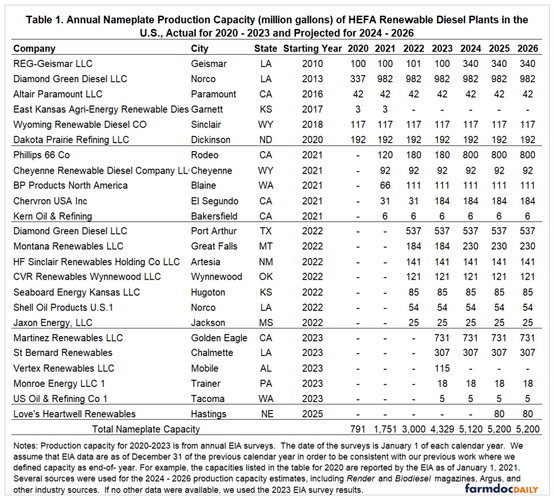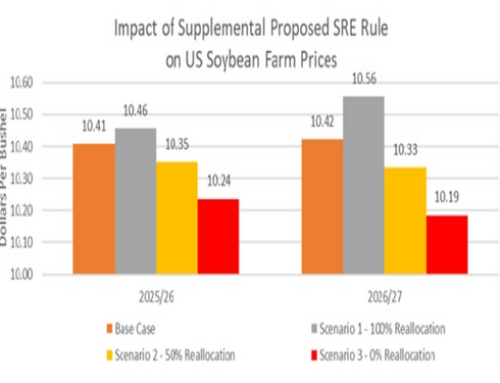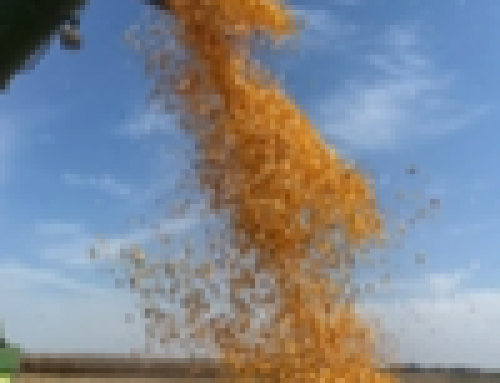 |
|---|
By Maria Gerveni and Scott Irwin, Department of Agricultural and Consumer Economics, University of Illinois and Todd Hubbs and Steven Ramsey, Economic Research Service, U.S. Department of Agriculture
Renewable diesel production capacity in the U.S. exploded in recent years, increasing over three billion gallons (farmdoc daily, March 8, 2023; March 29, 2023). This had a substantial impact on fats and oils feedstock markets, as well as diesel markets in states with low carbon fuel programs. Numerous announcements about additional renewable diesel plants have been made in the press, and based purely on this information, it appears that the renewable diesel boom is far from over. However, the profitability of renewable diesel production has taken a major hit in the last year (Khan and Jao, 2024), as the industry began to produce at a level greater than the demand ceiling set by the annual renewable volume obligations (RVOs) under the U.S. Renewable Fuel Standard (RFS) program. In an earlier farmdoc daily article (May 31, 2023), we explained the process as the biomass-based diesel industry going over the “RIN cliff.” In this uncertain environment, it is important to understand how much longer the boom in renewable diesel might last and how much more capacity may be added. Consequently, the purpose of this article is to update our estimates of renewable diesel production capacity through 2026. The analysis is based on a review of capacity that can be projected with reasonable confidence and that which cannot. This is the 19th in a series of farmdoc daily articles on the renewable diesel boom (see the complete list of articles here).
Analysis
The two main types of biomass-based diesel fuels used to comply with the U.S. Renewable Fuel (RFS) mandates are “FAME biodiesel” and “renewable diesel.” Although FAME biodiesel and renewable diesel are produced with the same organic fats and oils feedstocks, their production process differs substantially, resulting in the creation of two fundamentally different fuels (for details see farmdoc daily, February 8, 2023). The vast majority of renewable diesel in the U.S. is fully refined and cracked using HEFA (hydrotreated esters and fatty acids) petroleum refining technology. This results in a “drop-in” hydrocarbon fuel that meets the same performance specifications as petroleum diesel. Thus, it can be blended at any level, making it potentially a complete replacement for petroleum diesel. In contrast, biodiesel produced using FAME (fatty acid methyl ester) technology must be blended with petroleum diesel in relatively low proportions to be used in modern diesel engines.
Our updated estimates of HEFA renewable diesel plant capacity in the U.S. are shown in Table 1. Several sources are used. For 2020 through 2023, we use the list of plants and capacities collected by the Energy Information Agency (EIA) in its annual survey of nameplate production capacity. The date of the survey is January 1 of each calendar year (2021-2024). We assume the “as of” date for the survey is December 31 of the previous calendar year to be consistent with our previous work where we defined capacity as end-of-year. For example, the capacities listed in the table for December 31, 2020, are reported by the EIA as of January 1, 2021. Several sources are used for the 2024 – 2026 production capacity estimates, including the Render and Biodiesel magazines, Argus, and other industry sources. If no other data were available, we used the 2023 EIA survey results.
In total, Table 1 shows that there will be 22 renewable diesel plants in operation by the end of 2026. There are four expansions and one contraction included in this list. First, the REG-Geismer plant at Geismer, Louisiana expanded from 100 to 340 million gallons of annual capacity in 2024. Second, the Phillips 66 Co. plant at Rodeo, California expanded from 180 to 800 million gallons in 2024. With this expansion, the Phillips plant is by far the largest renewable diesel plant in the U.S. Third, Montana Renewables plant at Great Falls, Montana expanded in 2024 from 184 to 230 million gallons. Fourth, the Love’s Heartwell Renewables plant at Hastings, Nebraska is on schedule to begin operating in 2025 with a nameplate capacity of 80 million gallons. The sources we consulted indicated that this is the only new renewable diesel plant with a confirmed start date between 2024 and 2026. Fourth, the 115-million-gallon Vertex Renewables plant at Mobile, Alabama that began operation in 2023 filed for bankruptcy earlier in 2024 and has ceased operation.
To read entire report, Click Here.




